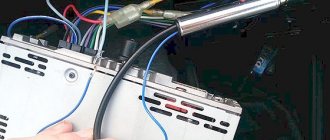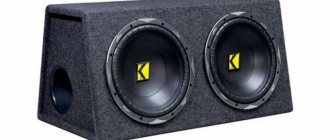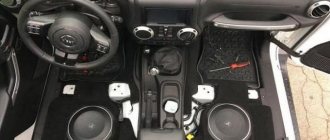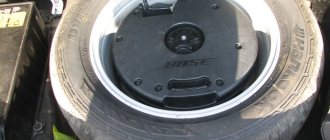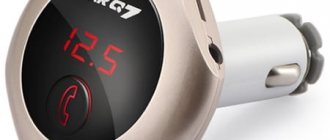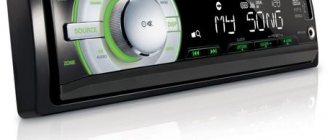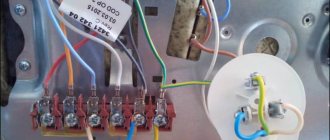How to connect a subwoofer
A subwoofer is a sound reproduction device designed for low-frequency sound. In other words, it produces bass that enhances the rhythm of the music being played.
As a rule, it is not included in the speaker system; it must be connected additionally. And this is often associated with large labor costs if you do it yourself, or additional financial investments in your iron horse if you contact a car service.
Therefore, connecting it is purely voluntary and is determined only by the love of loud music.
To the standard radio
To connect a subwoofer to a standard radio, you first need to check whether there are connectors for the corresponding wires on its rear panel. Usually these are the well-known “tulips” of red, yellow and white colors. If you have them, the process becomes much simpler. In addition, active and passive subwoofer options should be distinguished. The first has little effect, but the second gives an excellent result: when listening to music through it, special emphasis is placed on the bass and rhythm.
Additional wires required to connect the standard radio to the subwoofer can be purchased at any auto store. To make the design look neat, the wires are hidden under the car's trim. In fact, it turns out that they are stretched across the entire cabin right under the hood, and their chaotic arrangement throughout the interior of the car, and not only will it not add aesthetics, it will also disturb passengers, especially when entering or exiting the car.
To a foreign radio
To connect a subwoofer to a non-factory radio you will need:
- amplifier;
- wiring for power connection;
- connections between the radio itself;
- amplifier and speakers themselves.
We recommend:
Rear view cameras for cars: review of the best cameras and their features
In this case, the wires will have to be purchased additionally, and it will be necessary to take into account not only the brand of the radio, but also the car, including the year of its manufacture.
First you will need to remove the radio from the socket. Try not to pick at it with screwdrivers to do this, but if there are no other ways, this one will do. Look at what inputs are on the back panel. Modern radios all have connectors for connecting a subwoofer. Most likely it will be tulips.
Connect the wires to them according to the colors. They will have to connect the radio and amplifier. Then the wires coming from the speakers themselves in accordance with the positive and negative terminals.
And don’t forget about connecting the amplifier to the battery.
Active and passive subwoofers
As a rule, radios or other head units of car audio systems are not designed to connect subwoofers. This is because the quality of bass reproduction is mainly determined by the front speakers, which do not require a high-power signal.
Subwoofers come to mind when loud, powerful, deep bass, high sound pressure and new physical sensations are required. Typically, radio tape recorders are not capable of providing the powerful electrical signal required for this.
In principle, a low-power low-frequency speaker, using filters (crossovers) to divide the frequency load between speakers of different types, can be connected to the standard outputs of many head units (radio tape recorders), if they are capable of providing an output signal power of at least 20 W per channel. But if high bass sound pressure is required, additional amplification is indispensable.
Typically, passive subwoofers are connected to the sound source through an external amplifier. The advantages of such a scheme are, first of all, flexibility. To achieve the required sound quality or bass volume, you can change both speakers and amplifiers independently of each other.
Passive subwoofer connection panel
Active subwoofers have an audio power amplifier built into the same housing as the speakers. This is a compact solution that saves space and time, as it is much easier to install and connect. In addition, an active boxed subwoofer usually costs less than a passive and external amplifier combined.
Active subwoofer with connection panel
Nevertheless, when choosing such a scheme, you should be prepared for the fact that pitfalls will reveal themselves over time. Sound quality depends on both the amplifier and the speaker. But replacing one of the components in an active device is almost impossible.
We recommend: CVT gearbox for cars
The second minus is the quality of the amplifier. Manufacturers of universal devices are focused on the maximum capabilities of their products, which expands the list of potential buyers.
The built-in amplifier is usually designed to operate in certain conditions. Such a device cannot be upgraded when the sound quality no longer meets increased needs.
Table: comparison of advantages and disadvantages
| Advantages | Flaws | |
| Passive subwoofer |
|
|
| Active subwoofer |
|
|
Video on the topic
How to connect a subwoofer to an amplifier
First of all, it is worth remembering that the power of the subwoofer and amplifier must match. If in doubt, consult your retailer when purchasing both devices. Otherwise, the sound will not be of sufficient quality, and voltage surges can completely damage the system.
When connecting the subwoofer to the amplifier, do not forget about the positive and negative terminals, as well as the standard fuses on the wires. If these are not included initially, be sure to purchase them separately. They will protect the system from energy surges and save energy consumption.
The ground wire is attached to an unpainted metal surface. Here everything depends on convenience and its length. It is often attached to the screw from the seat. Make sure to clean the end of the wire well so that nothing interferes with the process.
When connecting wires directly from the radio, do not forget about the power cord. If you lose sight of it, the system simply will not work. Usually this is a thin blue wire going to the central entrance.
We recommend:
DIY subwoofer: instructions and video
How to connect a sound amplifier: diagrams
Active and passive subwoofers are connected to the sound source using different circuits.
Passive
Connecting using filters (crossovers) directly to the acoustic outputs (not to the linear “tulips”) of the head unit (radio) via a bridge circuit makes sense if its output power is above 20 W per channel.
Using a bridge circuit, the subwoofer inputs are connected to the outputs of channels of different polarities
The subwoofer inputs are connected to the outputs of amplifier stages of different polarities. To avoid overload, filters are selected in such a way that the frequencies of the main channels and the subwoofer do not overlap.
Practical connection diagrams may vary depending on the head unit model. In any case, you should not connect one of the speaker terminals directly to the car body.
If the head unit (radio tape recorder) does not support a bridge circuit, the subwoofer is connected to the positive outputs of the left and right channels.
When the radio does not support a bridge circuit, the subwoofer is connected to the positive outputs of the channels
Connecting a subwoofer directly to the radio is the exception rather than the rule. Typically the signal reaches the speaker through an amplifier. For this purpose, devices with different numbers of channels can be used.
The amplifier input is connected to the linear output - to the “tulips” - of the head unit using an interconnect cable. Using the acoustic outputs of the radio to connect an amplifier is permissible if the latter supports this mode (equipped with a high-level input). However, it should be remembered that in this case the sound quality suffers.
When the amplifier has only one channel, the speaker is simply connected to its output. To do this, use either special speaker wires or the same ones as the one with which the amplifier is connected to the positive terminal of the battery. In any case, the cross-sectional area of the wire for transmitting a low-frequency audio signal must be close to the same parameter as the power one.
Monoblock for connecting a subwoofer
A passive subwoofer can be connected to a multi-channel amplifier via a bridge circuit. In this case, the total power is approximately four times the value of the parameter of one channel.
The frequency of the sound signal entering the passive subwoofer should be limited to the upper value of 50–150 Hz. If the filter is built into the amplifier, select the LPF switch position. The cutoff threshold is adjusted by ear according to the bass sound quality. When the amplifier is not equipped with filters, an external crossover is used.
Amplifier Low Pass Filter Controls
Active
An active subwoofer consists of an amplifier and a speaker. It is connected to the car battery with a separate wire through a fuse, observing the requirements for connecting amplifiers.
When choosing the caliber - according to the AWG standard - of the power wire, they are guided by the length and strength of the current consumed (amplifier characteristics). The greater the current value and the longer the wire, the larger the cross-sectional area required to transfer energy without loss, the smaller the gauge value. Recommendations for selection are given in the table.
Table: caliber of power wire depending on length and current strength
| Amplifier current consumption | Power wire length | |||||||
| up to 1 m | 1–2 m | 2–3 m | 3–4 m | 4–5 m | 5–6 m | 6–7 m | 7–8 m | |
| up to 20 A | AWG 14 | AWG 12 | AWG 12 | AWG 10 | AWG 10 | AWG 8 | AWG 8 | AWG 8 |
| 20–35 A | AWG 12 | AWG 10 | AWG 8 | AWG 8 | AWG 6 | AWG 6 | AWG 6 | AWG 4 |
| 35–50 A | AWG 10 | AWG 8 | AWG 8 | AWG 6 | AWG 4 | AWG 4 | AWG 4 | AWG 4 |
| 50–65 A | AWG 8 | AWG 8 | AWG 6 | AWG 4 | AWG 4 | AWG 4 | AWG 4 | AWG 2 |
| 65–85 A | AWG 6 | AWG 6 | AWG 4 | AWG 4 | AWG 2 | AWG 2 | AWG 2 | AWG 0 |
| 85–105 A | AWG 6 | AWG 6 | AWG 4 | AWG 2 | AWG 2 | AWG 2 | AWG 2 | AWG 0 |
| 105–125 A | AWG 4 | AWG 4 | AWG 4 | AWG 2 | AWG 0 | AWG 0 | AWG 0 | AWG 0 |
| 125–150 A | AWG 2 | AWG 2 | AWG 2 | AWG 0 | AWG 0 | AWG 0 | AWG 0 | AWG 00 |
We recommend: What is an engine knock sensor
The power cable is laid close to the rest of the car wiring. To protect against short circuits and overloads, a fuse is installed in the circuit. Its rating must correspond to the caliber (section) of the wire. Recommendations for selection are shown in the table.
Table: fuse rating depending on wire cross-sectional area and AWG gauge
| Sectional area (mm2) | Cable Gauge (AWG) | Maximum fuse rating (A) |
| 0,5 | 20 | 5 |
| 0,75 | 18 | 7,5 |
| 1 | 17 | 10 |
| 1,5 | 15 | 15 |
| 2,5 | 13 | 25 |
| 4 | 11 | 30 |
| 6 | 9 | 40 |
| 8 | 8 | 50 |
| 10 | 7 | 60 |
| 16 | 5 | 80 |
| 20 | 4 | 100 |
| 25 | 3 | 125 |
| 30 | 2 | 150 |
| 50 | 200 | |
| 70 | 000 | 250 |
| 95 | 0000 | 300 |
A dry and accessible location for installing the fuse is chosen near the battery, no further than 30 cm from the positive terminal. The fuse holder is rigidly fixed to the housing.
Installing a fuse in the engine compartment
It is recommended to use a capacitor. Its purpose is to suppress high-frequency interference (noise) in the audio path and smooth out on-board network voltage ripples due to peak surges in current consumption.
Car audio capacitor
A capacitor with a capacity of approximately 0.1 farad per 100 W of subwoofer amplifier power is installed between the positive power wire and the housing no further than 60 cm from the device or connected to a special connector, if available.
To connect the active subwoofer to the signal source (head unit), an interconnect (line) cable is used.
Interconnect cable for connecting to linear outputs
To reduce interference and interference, the line cable is laid as far as possible from the vehicle's on-board wiring. If the number of connectors on the radio is insufficient, splitters (Y-adapters) are used.
Branching of line outputs using Y-adapters
The REM control connector is connected to a similar output of the radio using any conductor.
Connecting computer and household active subwoofers
Automotive active subwoofers differ from computer and household subwoofers in design and power supply. As a rule, speakers and housings of devices intended for use in a car are adapted to vibrations, dust, changes in temperature and humidity. In addition, they are designed to be powered from an on-board DC network with a nominal voltage of 12 V.
Household devices are powered by AC power, so they cannot be connected to a car audio system without modification, with the exception of subwoofers with universal power supply.
AC Powered Household Subwoofer
The simplest modification is to remove the built-in amplifier along with the power supply, which turns the subwoofer from active to passive.
Due to the fact that household appliances are designed to operate in milder conditions than specialized ones, their service life in a car can be significantly reduced.
Video: installing a home subwoofer in a car
What wires do you need to connect the subwoofer?
In order to connect a subwoofer, you will need acoustic, interconnect and power wires. Each of these types has a specific functionality. They are often included in inexpensive sets; the quality of such sets cannot be trusted.
- Firstly, the wires may not be long enough for a proper connection.
- Secondly, despite the thick insulation, the wire itself may not be thick enough for such technical loads.
If you have already decided to purchase a set, then pay attention to the manufacturer. Branded kits will be expensive, but they will meet all the necessary requirements.
Ideally, it is better to buy these wires separately. This way, you can control the length, thickness and quality of the purchased wire based on the requirements specifically for your car and speaker system.
The speaker wires are of good thickness and have a copper base. The characteristics of the wire depend strictly on what connectors are provided on the equipment. The interconnect wire is an element in which you should invest the maximum, since here the quality directly depends on its price. The power cable directly affects the safety of the car, so you shouldn’t skimp on it either. The optimal length is around five meters.
Connecting to an amplifier
Classification of subwoofers and methods of installing them in a car
All car subwoofers are divided into two large classes: passive and active.
- A passive subwoofer is a box with speakers built into it. In order for such a subwoofer to work, you will have to additionally purchase a sound amplifier of appropriate power, since passive subwoofers do not have their own amplifier.
- Active subwoofers differ from passive ones in that they have their own built-in amplifier.
We recommend: Thermostat: principle of operation, types, device, photo, video.
In fact, an active subwoofer is a ready-to-use acoustic system that is suitable, perhaps, for most car enthusiasts, except for those who have special requirements for sound quality. Very often, active subwoofers also have the ability to adjust sound frequencies and bass levels.
There is another type of subwoofer that does not have a housing and is a speaker with or without an amplifier - they are called frameless.
Cabinetd subwoofers, in turn, differ from each other in the shape of the housing and the material from which it is made:
- Regardless of the type of subwoofer (active or passive), the body shape can be round, square or rectangular.
- The material used to make the body can be multilayer plywood, chipboard or even fiberboard.
The frequency characteristics of the subwoofer also depend on the material of the housing, as well as its shape.
Methods for installing a subwoofer in a car
In most cases, subwoofers are installed in the trunk of a car, and the installation locations may vary. Most often, the subwoofer is attached to the back of the rear seat, but there are also options when the “sub” is installed on the side in the luggage compartment.
Woofers that do not have a cabinet are typically installed in the following locations:
- In the interior trim of the car;
- In the trunk floor;
- The housing is made according to individual calculations, taking into account the characteristics of the free space in the car. Such subwoofers occupy a minimum of usable space in the luggage compartment of the car.
There are also compact models of subwoofers that are installed under the front seats of a car. However, such devices are not very powerful.
After determining the installation location, the subwoofer is directly installed in the car and its further connection to the car’s on-board network and to the amplifier or car radio.
Subwoofer connection diagram
If you try to compact all of the above into a single circuit, it will look like this: battery, amplifier, radio, amplifier, subwoofer. That is, the amplifier is almost the main element, since the largest number of wires are pumped to it. Cables already diverge from them, which go to the radio, speakers and battery. Therefore, the choice of amplifier must be treated with special care.
We recommend:
Instructions for using Webasto on diesel and gasoline
Connecting coils
To reduce resistance, subwoofers use elements such as coils. They can have a value of 2, 4 and 8 ohms. Their connection diagrams are also different. It can be parallel, sequential and combined. With a parallel connection, the resistance decreases, with a series connection, on the contrary, it increases.
- The first is needed to increase the power of the amplifier with a general calculation for a low load. Only the sound quality may suffer from this.
- The second option is designed for more powerful equipment and makes the sound cleaner and clearer.
- To distribute the load, two types of connections can be used simultaneously, forming a third - combined. In this case, there are several options, it all depends on the individual characteristics of the speaker system and its technical capabilities.
General scheme
Connection cost
The average cost of connecting a subwoofer is 15 thousand rubles.
It all depends on the amount of work that will have to be done, as well as on the configuration of the speaker system. For installation, it may be necessary to cut out the stands for the speakers themselves, and this will require large expenses, since in order for the work to subsequently look neat, almost jeweler-like precision is required.
The length of the wires through the cabin, as well as the method of hiding them from prying eyes, may also imply different labor and time costs. You may have to unfasten and then reinstall the door sill trim, unscrew the seat, etc. As for the technical side of the issue itself, everything here depends only on the professionalism of the master and the image of the car service. It is possible to install a subwoofer using a makeshift method with your own hands, but it is not a fact that everything will work as it should, and then at the service center the entire structure will have to be dismantled and reinstalled, and this will obviously cost more than if everything was done from scratch.
Connecting the sub: important points and instructions
Let's look at the process of installing a subwoofer in a car with a connection to the standard radio. Before starting work, pay attention to a few points:
- The subwoofer housing and the amplifier itself are large devices. We need to think about where to place them. Most often, a place is allocated for them in the luggage compartment of a car.
If possible, the amplifier is placed on the back of the rear sofa. Remember that the amplifier and active subwoofer become hot during operation. These devices require good cooling. Position the amplifier and sub so that air can circulate freely around the devices.
- If the standard head unit does not have outputs for connecting a subwoofer and there is no control wire, then think about replacing the radio. This will protect you from possible short circuits, simplify connecting the subwoofer and allow you to get high-quality sound. An active woofer requires battery power. The power cable must be of appropriate length and cross-section. Consider where to route it from the engine compartment to the luggage compartment. It must be firmly fixed with plastic clamps.
- Check the presence of a line output for the subwoofer on the standard radio. If not, there is a way out. The subwoofer is connected to speakers or AUX output. This solution is not ideal and affects the quality of sound reproduction.
- To control the active subwoofer, a System Remote Control wire is required. Without it, the amplifier module does not work. If the radio does not have such an output, then you can directly supply constant +12 volts to the input of the active subwoofer. With this connection, the amplifier operates continuously and discharges the battery.
